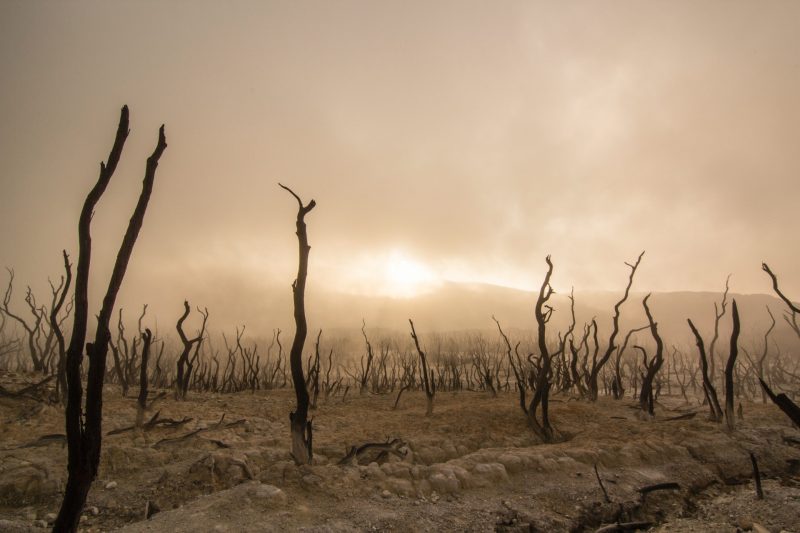

The oxygen currently in Earth’s atmosphere will be gone in a billion years, say scientists. This image of Earth’s atmosphere was taken from the International Space Station on February 26, 2021. Image via NASA.
Take a deep breath. The air expanding your chest is mostly nitrogen and oxygen, the chief components of our atmosphere. Oxygen exists in our atmosphere thanks to the exhalation of plants, through the process of photosynthesis. A study released in March 2021 shows that – a billion years from now, as the sun heats up – plants will die off, taking with them the oxygen in our atmosphere that humans and animals need to breathe.
Kazumi Ozaki of the University of Tokyo and Chris Reinhard of Georgia Tech modeled Earth’s climatic, biological and geological systems to fine tune scientists’ understanding of future atmospheric conditions on Earth. They undertook the research as part of a NASA program called NExSS to explore and assess the habitability of exoplanets. Their study was published March 1, 2021, in the peer-reviewed journal Nature Geoscience.
Earth’s present atmosphere is made up of 78 percent nitrogen, 21 percent oxygen, 0.9 percent argon, and 0.1 percent other gases, including carbon dioxide, methane, water vapor and neon. Earth hasn’t always had such a high percentage of oxygen in its atmosphere. For the first 2 billion years on Earth, no oxygen existed in the atmosphere. Low levels of oxygen first appeared as cyanobacteria, such as blue-green algae, began releasing oxygen as a byproduct of photosynthesis. Then, about 2.4 billion years ago, Earth underwent the Great Oxidation Event. At this point, whether through a slackening in the outgassing of volcanoes or an evolutionary innovation that made cyanobacteria more successful, oxygen began to accumulate in larger amounts in the atmosphere, killing off some bacteria but allowing more complex life (us!) to evolve.
This oxygen utopia in which we currently – where plants produce oxygen for humans and animals to breathe – is only a temporary condition on Earth. As Ozaki said:
We find that the Earth’s oxygenated atmosphere will not be a permanent feature.

Kazumi Ozaki of the University of Tokyo, lead author on the paper investigating the future of oxygen on Earth. Image via NASA.
As the solar system continues its life cycle, the aging sun will begin to heat up. The increased solar output will further warm the atmosphere, and the carbon dioxide will react to the increase in temperature by breaking down. Carbon dioxide levels will lower until photosynthesizing organisms – which rely on taking in carbon dioxide to live, just as we rely on oxygen to live – can no longer survive, removing the source of oxygen from Earth. (Read about how scientists believe that phytoplankton contribute between 50 to 85 percent of the oxygen in Earth’s atmosphere.) So when plants die from the lack of carbon dioxide, it’s not just a loss in the food chain but, crucially, a loss in the air they produce and the air we breathe.
While the end of oxygen is still a billion years away, when the depletion begins to take hold, it will occur rather rapidly, in about 10,000 years. Reinhard explained the severity of the change:
The drop in oxygen is very, very extreme – we’re talking around a million times less oxygen than there is today.

Chris Reinhard of Georgia Tech, one of the lead authors who researched the future amount of oxygen in Earth’s atmosphere. Image via NExSS.
The future deoxygenation event will coincide with a rise in methane, until methane levels are about 10,000 times more than exist in the atmosphere today. These shifts will occur too fast for adaptation in the biosphere. The ozone layer, made of oxygen, will vanish, and ultraviolet light and heat will aid in extinguishing both terrestrial and aquatic life. All but microbes will face extermination. Reinhard said:
A world where many of the anaerobic and primitive bacteria are currently hiding in the shadows will, again, take over.
Just as in the beginning, when life on Earth was in a microbial form before flourishing into the variety we see today, so too will the future look much like the past, as if the clock is running backward, and complex life forms will go extinct except for tiny colonies of cells.

All plant and animal life on Earth needs oxygen to survive. A billion years from now, Earth’s oxygen will become depleted in a span of about 10,000 years, bringing about worldwide extinction for all except microbes. Image via Dikaseva/ Unsplash.
Studying the past and future of Earth is a gateway to understanding the conditions favorable to life on other planets. The presence of oxygen is an important factor in determining if life might exist on a planet. As we see with Earth, however, a planet that doesn’t have an oxygen signature may be capable of supporting life in the future or in the past.
Thus, while finding a planet with oxygen would be an exciting step toward finding life, not finding oxygen shouldn’t rule out the possibility that a planet ever had life.
Bottom line: A billion years from now, scientists say, as the sun heats up the warmer atmosphere will break down carbon dioxide, killing off plant life, which in turn will shut off Earth’s source of oxygen.
Source: The future lifespan of Earth’s oxygenated atmosphere
from EarthSky https://ift.tt/3ccYzJN


The oxygen currently in Earth’s atmosphere will be gone in a billion years, say scientists. This image of Earth’s atmosphere was taken from the International Space Station on February 26, 2021. Image via NASA.
Take a deep breath. The air expanding your chest is mostly nitrogen and oxygen, the chief components of our atmosphere. Oxygen exists in our atmosphere thanks to the exhalation of plants, through the process of photosynthesis. A study released in March 2021 shows that – a billion years from now, as the sun heats up – plants will die off, taking with them the oxygen in our atmosphere that humans and animals need to breathe.
Kazumi Ozaki of the University of Tokyo and Chris Reinhard of Georgia Tech modeled Earth’s climatic, biological and geological systems to fine tune scientists’ understanding of future atmospheric conditions on Earth. They undertook the research as part of a NASA program called NExSS to explore and assess the habitability of exoplanets. Their study was published March 1, 2021, in the peer-reviewed journal Nature Geoscience.
Earth’s present atmosphere is made up of 78 percent nitrogen, 21 percent oxygen, 0.9 percent argon, and 0.1 percent other gases, including carbon dioxide, methane, water vapor and neon. Earth hasn’t always had such a high percentage of oxygen in its atmosphere. For the first 2 billion years on Earth, no oxygen existed in the atmosphere. Low levels of oxygen first appeared as cyanobacteria, such as blue-green algae, began releasing oxygen as a byproduct of photosynthesis. Then, about 2.4 billion years ago, Earth underwent the Great Oxidation Event. At this point, whether through a slackening in the outgassing of volcanoes or an evolutionary innovation that made cyanobacteria more successful, oxygen began to accumulate in larger amounts in the atmosphere, killing off some bacteria but allowing more complex life (us!) to evolve.
This oxygen utopia in which we currently – where plants produce oxygen for humans and animals to breathe – is only a temporary condition on Earth. As Ozaki said:
We find that the Earth’s oxygenated atmosphere will not be a permanent feature.

Kazumi Ozaki of the University of Tokyo, lead author on the paper investigating the future of oxygen on Earth. Image via NASA.
As the solar system continues its life cycle, the aging sun will begin to heat up. The increased solar output will further warm the atmosphere, and the carbon dioxide will react to the increase in temperature by breaking down. Carbon dioxide levels will lower until photosynthesizing organisms – which rely on taking in carbon dioxide to live, just as we rely on oxygen to live – can no longer survive, removing the source of oxygen from Earth. (Read about how scientists believe that phytoplankton contribute between 50 to 85 percent of the oxygen in Earth’s atmosphere.) So when plants die from the lack of carbon dioxide, it’s not just a loss in the food chain but, crucially, a loss in the air they produce and the air we breathe.
While the end of oxygen is still a billion years away, when the depletion begins to take hold, it will occur rather rapidly, in about 10,000 years. Reinhard explained the severity of the change:
The drop in oxygen is very, very extreme – we’re talking around a million times less oxygen than there is today.

Chris Reinhard of Georgia Tech, one of the lead authors who researched the future amount of oxygen in Earth’s atmosphere. Image via NExSS.
The future deoxygenation event will coincide with a rise in methane, until methane levels are about 10,000 times more than exist in the atmosphere today. These shifts will occur too fast for adaptation in the biosphere. The ozone layer, made of oxygen, will vanish, and ultraviolet light and heat will aid in extinguishing both terrestrial and aquatic life. All but microbes will face extermination. Reinhard said:
A world where many of the anaerobic and primitive bacteria are currently hiding in the shadows will, again, take over.
Just as in the beginning, when life on Earth was in a microbial form before flourishing into the variety we see today, so too will the future look much like the past, as if the clock is running backward, and complex life forms will go extinct except for tiny colonies of cells.

All plant and animal life on Earth needs oxygen to survive. A billion years from now, Earth’s oxygen will become depleted in a span of about 10,000 years, bringing about worldwide extinction for all except microbes. Image via Dikaseva/ Unsplash.
Studying the past and future of Earth is a gateway to understanding the conditions favorable to life on other planets. The presence of oxygen is an important factor in determining if life might exist on a planet. As we see with Earth, however, a planet that doesn’t have an oxygen signature may be capable of supporting life in the future or in the past.
Thus, while finding a planet with oxygen would be an exciting step toward finding life, not finding oxygen shouldn’t rule out the possibility that a planet ever had life.
Bottom line: A billion years from now, scientists say, as the sun heats up the warmer atmosphere will break down carbon dioxide, killing off plant life, which in turn will shut off Earth’s source of oxygen.
Source: The future lifespan of Earth’s oxygenated atmosphere
from EarthSky https://ift.tt/3ccYzJN

Aucun commentaire:
Enregistrer un commentaire